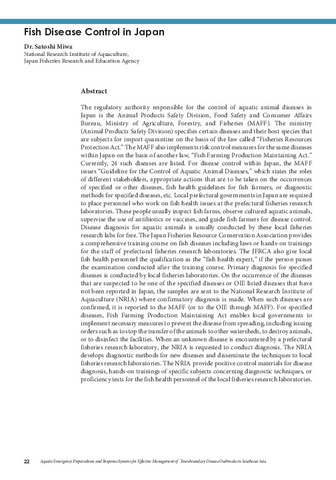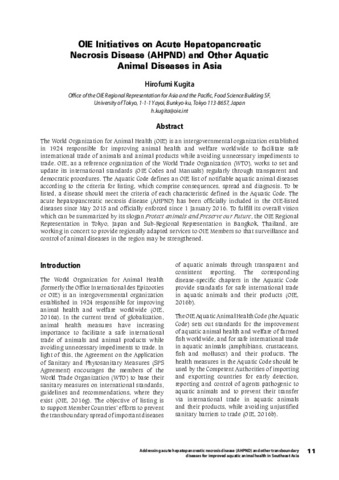AquaHealth Online: A new learning environment for capacity building in aquatic animal health
Share
abstrak
Due to significant requirement of trained personnel in Fish Health Management, the Aquaculture Department of the Southeast Asian Fisheries Development Center (SEAFDEC/AQD) offered 14 sessions of face-to-face (F2F) training (1988-2002) at its station in Iloilo. However, shrinking fellowship and travel funds necessitated a shift in training paradigm. Thus, transformation of teaching materials used in F2F trainings resulted to AquaHealth Online, a team developed and electronically delivered course on Health Management in Aquaculture. The general objective of the course transformation was to train a large pool of geographically dispersed participants at minimum cost, and this paper reports on the experience earned in course development, delivery and outcome. To enable Fish Health specialists to develop materials and skills to deliver courses for the online environment, SEAFDEC/AQD collaborated with the University of the Philippines Open University to help adapt, enhance, and reformulate materials in the F2F course for online delivery. The specialists underwent hours of training in "techno-pedagogy", or ways of transforming teaching activities into formats that could be understood even in our absence. The primary learning resource is a CD-ROM that provides interactive information with self-assessment questions. The course covers 12 modules in 4 units: I. Introduction to Fish Health Management; II. Infectious Diseases of Fish and Crustaceans; III. Non-Infectious Diseases; and IV. Disease Diagnosis, Prevention and Control. Learning enhancement and discussion occurs through internet-based Discussion Boards (DBs) presided over by module specialists. The DBs serve as media for asynchronous discussions and makes a permanent record of lessons learned. When first offered in 2002, AquaHealth Online had 25 enrollees from 10 countries. In 2003, there were 17 participants from 8 countries. Participants were led to "just-in" relevant information and encouraged to submit assignments from internet resources. This course is an example that a state-of-the-art online course can be as effective as F2F training.
Suggested Citation
Lavilla-Pitogo, C. R., & Torres Jr., P. L. (2004). AquaHealth Online: A new learning environment for capacity building in aquatic animal health. In C. R. Lavilla-Pitogo & K. Nagasawa (Eds.), Transboundary Fish Diseases in Southeast Asia: Occurence, Surveillance, Research and Training. Proceedings of the Meeting on Current Status of Transboundary Fish Diseases in Southeast Asia: Occurence, Surveillance, Research and Training, Manila, Philippines, 23-24 June 2004 (pp. 53-66). Tigbauan, Iloilo, Philippines: SEAFDEC Aquaculture Department.
Subjek
Related items
Showing items related by title, author, creator and subject.
-
OIE international standards on aquatic animals
Wang, Jing (Aquaculture Department, Southeast Asian Fisheries Development Center, 2019)The World Organisation for Animal Health (OIE) is the intergovernmental organisation responsible for improving animal health worldwide. It is recognised as a reference organisation by the World Trade Organization (WTO) to ... -
Fish disease control in Japan
Miwa, Satoshi (Aquaculture Department, Southeast Asian Fisheries Development Center, 2019)The regulatory authority responsible for the control of aquatic animal diseases in Japan is the Animal Products Safety Division, Food Safety and Consumer Affairs Bureau, Ministry of Agriculture, Forestry, and Fisheries ... -
OIE initiatives on acute hepatopancreatic necrosis disease (AHPND) and other aquatic animal diseases in Asia
Kugita, Hirofumi (Aquaculture Department, Southeast Asian Fisheries Development Center, 2016)The World Organization for Animal Health (OIE) is an intergovernmental organization established in 1924 responsible for improving animal health and welfare worldwide to facilitate safe international trade of animals and ...





